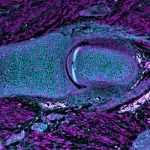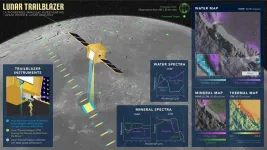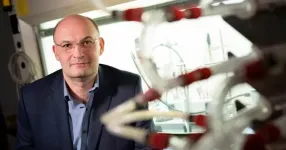(Press-News.org) The efficient architecture of our joints, which allows our skeletons to be flexible and sturdy, originated among our most ancient jawed fish ancestors, according to a study published February 25th in the open-access journal PLOS Biology by Neelima Sharma of the University of Chicago and colleagues.
Synovial joints are a key feature of most vertebrate skeletons, providing more mobility and stability compared to other joint types. A synovial joint allows bones or cartilage to slide past each other with the aid of a lubricated cavity between them. These joints are present in land vertebrates and bony fish, suggesting this feature had evolved in the common ancestors of these groups, but it remains unclear when in early vertebrate evolution these joints originated.
In this study, Sharma and colleagues examined the anatomy and development of joints in members of two early-branching vertebrate lineages: one species of jawless fish, sea lampreys, and two species of cartilaginous fish, bamboo sharks and little skates. Analysis revealed cavitated joints in the cartilaginous fish, but not in lampreys. Additionally, the cartilaginous fish exhibited certain proteins and developmental processes that are shared with synovial joints of other vertebrates. Furthermore, the researchers employed CT-scans to identify a similar cavitated joint in the fossil fish Bothriolepis, the most ancient known synovial joint.
Altogether, these results show that synovial joints are shared across jawed fish, but apparently absent in jawless fish, indicating that these joints first evolved in the ancestors of jawed vertebrates. This study provides critical information for research into the origins of the skeletal architecture of vertebrates, including ourselves. The authors suggest that future steps might include analysis of joint morphology in other fossil fish lineages and further comparisons between joints of jawed and jawless vertebrates to uncover more details about early joint evolution.
The authors add, “The origin of mobile joints in our fish ancestors enabled them to move about and feed in new ways. This study shows that the developmental processes that are responsible for these joints arose deep within the fish evolutionary tree.”
In your coverage, please use this URL to provide access to the freely available paper in PLOS Biology: https://plos.io/3Qzgcbr
Citation: Sharma N, Haridy Y, Shubin N (2025) Synovial joints were present in the common ancestor of jawed fish but lacking in jawless fish. PLoS Biol 23(2): e3002990. https://doi.org/10.1371/journal.pbio.3002990
Author countries: United States
Funding: This work was supported by the Brinson Family Foundation (https://brinsonfoundation.org/), the University of Chicago Biological Sciences Foundation, and HFSP (RGP0010/2022, https://www.hfsp.org/) to N.Shubin. The funders had no role in study design, data collection and analysis, decision to publish, or preparation of the manuscript.
END
Humans inherited their flexible joints from the earliest jawed fish
Synovial joints identified for the first time in multiple ancient fish lineages
2025-02-25
ELSE PRESS RELEASES FROM THIS DATE:
Understanding the world within: Study reveals new insights into phage–bacteria interactions in the gut microbiome
2025-02-25
A world of microbes resides within the gut of every human being. This vast microbial community, the microbiome, which includes bacteria and viruses, has repeatedly demonstrated its ability to actively contribute to both health and disease.
Researchers have learned a good deal about the bacterial communities that live in the human gut. For instance, they have discovered that these bacteria extensively metabolize the food we eat, drive normal development of the immune system and, to our detriment, include some opportunistic microorganisms that can cause disease under certain conditions.
On the other hand, the contributions of viruses in the gut microbiome ...
Cold treatment does not appear to protect preterm infants from disability or death caused by oxygen loss, according to NIH-funded study
2025-02-25
WHAT:
Lowering the body temperature of preterm infants (born at 33 to 35 weeks of pregnancy) with hypoxic ischemic encephalopathy (HIE)—a type of brain damage caused by oxygen loss—offers no benefits over standard care, according to a study funded by the National Institutes of Health (NIH). Previous studies of near-term and term infants (born after 36 weeks) with HIE found that this cooling treatment, which lowers body temperature to about 92 degrees Fahrenheit, significantly reduced the risk of death or disability by age 18 months (corrected for prematurity). However, the current findings show ...
Pennington Biomedical researchers uncover role of hormone in influencing brain reward pathway and food preferences
2025-02-25
BATON ROUGE – When faced with multiple food options and ultimately choosing one, the factors of that decision-making process may be more physiological than previously assumed. A group of scientists led by Pennington Biomedical Research Center’s Dr. Christopher Morrison recently discovered that the hormone fibroblast growth factor 21, or FGF21, plays an influential role in brain reward mechanisms like those involved in dietary choices.
The discovery was announced in the research team’s recent paper titled “FGF21 ...
Rethinking equity in electric vehicle infrastructure
2025-02-25
As electric vehicles (EVs) gain momentum in the fight against climate change, the conversation around public charging infrastructure is growing increasingly complex. Xinwu Qian , assistant professor of civil and environmental engineering at Rice University, is spearheading research that reimagines how and where charging stations should be deployed — ensuring that alignment with people’s daily routine and activities, beyond mere accessibility, are at the forefront.
“Charging an electric vehicle isn’t just about plugging it in and waiting — it takes 30 minutes to an hour even with the fastest charger ...
Lunar Trailblazer blasts off to map water on the moon
2025-02-25
On Wednesday 26 February, a thermal imaging camera built by researchers at the University of Oxford’s Department of Physics will blast off to the Moon as part of NASA’s Lunar Trailblazer mission. This aims to map sources of water on the Moon to shed light on the lunar water cycle and to guide future robotic and human missions.
Once in orbit, the spacecraft – weighing 200kg and about the size of a washing machine- will map the surface temperature and composition of the ...
Beacon Technology Solutions, Illinois Tech awarded grant to advance far-UVC disinfection research
2025-02-25
CHICAGO—February 24, 2025—Beacon Technology Solutions (Beacon), with collaborators at Illinois Institute of Technology (Illinois Tech), has been awarded a grant to support a novel study on how Far-UVC technology can help mitigate the spread of infectious diseases in public spaces. The grant was awarded through the Illinois Innovation Vouchers (IIV) Program, which fosters research collaborations between small- and medium-sized enterprises and Illinois’ world-class universities.
Beacon’s flagship product is a wall-mounted smart disinfection device that uses Far-UVC 222nm light, which has been shown to disinfect up to 99.99 percent ...
University of Houston researchers paving the way for new era in medical imaging
2025-02-25
New technology developed by researchers at the University of Houston could revolutionize medical imaging and lead to faster, more precise and more cost-effective alternatives to traditional diagnostic methods.
For years, doctors have relied on conventional 2D X-rays to diagnose common bone fractures, but small breaks or soft tissue damage like cancers often go undetected. More expensive and time-consuming MRI scans are not always suitable for these tasks in these detection or screening settings. Now, Mini Das, Moores professor at UH’s College of Natural Sciences and Mathematics and Cullen College ...
High-tech startup CrySyst provides quality-by-control solutions for pharmaceutical, fine chemical industries
2025-02-25
WEST LAFAYETTE, Ind. — International process systems and operation experts have launched high-tech startup Crystallization Systems Technology Inc. (CrySyst) to streamline processes used by companies in the pharmaceutical and fine chemical industries.
CrySyst’s quality-by-control (QbC) framework addresses crystallization monitoring, modeling and control. The framework is based on research published in the April 15, 2020, and Oct. 5, 2021, issues of the journal Crystal Growth & Design and the Sept. 22, 2022, issue of the journal Industrial & Engineering ...
From scraps to sips: Everyday biomass produces drinking water from thin air
2025-02-25
Discarded food scraps, stray branches, seashells and many other natural materials are key ingredients in a new system that can pull drinkable water out of thin air developed by researchers from The University of Texas at Austin.
This new “molecularly functionalized biomass hydrogels” system can convert a wide range of natural products into sorbents, materials that absorb liquids. By combining these sorbents with mild heat, the researchers can harvest gallons of drinkable water out of the atmosphere, even in dry conditions.
“With ...
Scientists design novel battery that runs on atomic waste
2025-02-25
COLUMBUS, Ohio – Researchers have developed a battery that can convert nuclear energy into electricity via light emission, a new study suggests.
Nuclear power plants, which generate about 20% of all electricity produced in the United States, produce almost no greenhouse gas emissions. However, these systems do create radioactive waste, which can be dangerous to human health and the environment. Safely disposing of this waste can be challenging.
Using a combination of scintillator crystals, high-density materials that emit light when they absorb radiation, and solar cells, the team, led by researchers from The Ohio State University, demonstrated that ambient ...
LAST 30 PRESS RELEASES:
Review article | Towards a Global Ground-Based Earth Observatory (GGBEO): Leveraging existing systems and networks
Penn and UMich create world’s smallest programmable, autonomous robots
Cleveland researchers launch first major study to address ‘hidden performance killer’ in athletes
To connect across politics, try saying what you oppose
Modulating key interaction prevents virus from entering cells
Project explores barriers to NHS career progression facing international medical graduates
Jeonbuk National University researchers explore the impact of different seasonings on the flavor perception of Doenjang soup
Two Keck Medicine of USC Hospitals named Leapfrog Top Teaching Hospitals
World-first discovery uncovers how glioblastoma tumours dodge chemotherapy, potentially opening the door to new treatments
A fatal mix-up: How certain gut bacteria drive multiple sclerosis
New AI tool identifies not just genetic mutations, but the diseases they may cause
Deep-learning model predicts how fruit flies form, cell by cell
Combination pills for high blood pressure may simplify treatment, improve long-term health
Immune system keeps mucosal fungi in check
Neurons within the brain use simple rules to localize genetic messages
Electrodes created using light
Second-hand gift-giving is a well-deliberated decision
How human interaction drove evolution to make bears less aggressive
National Poll: Few parents offer teens guidance on healthy eating during holiday season
Cannabis derivatives could provide new ovarian cancer treatments
Raising strong yeast as a petroleum substitute
Clues to the origin of hot Jupiters hidden in their orbits
Canada’s reduced pledge to Global Fund will impact domestic health
1 in 4 children with major traumatic injuries not cared for in pediatric trauma centres
Duke and Duke-NUS’ joint cross-population research to uncover "East-West" differences in disease and care
Scientists to ‘spy’ on cancer- immune cell interactions using quantum technology breakthrough
Tech savvy users have most digital concerns
Making lighter work of calculating fluid and heat flow
Normalizing blood sugar can halve heart attack risk
Lowering blood sugar cuts heart attack risk in people with prediabetes
[Press-News.org] Humans inherited their flexible joints from the earliest jawed fishSynovial joints identified for the first time in multiple ancient fish lineages





